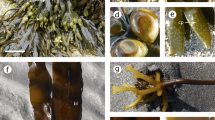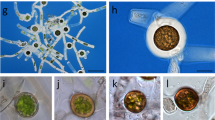Abstract
The cell wall of the red alga Bangia atropurpurea is composed of three unique polysaccharides (β-1,4-mannan, β-1,3-xylan, and porphyran), similar to that in Porphyra. In this study, we visualized β-mannan in the regenerating cell walls of B. atropurpurea protoplasts by using a fusion protein of a carbohydrate-binding module (CBM) and green fluorescent protein (GFP). A mannan-binding family 27 CBM (CBM27) of β-1,4-mannanase (Man5C) from Vibrio sp. strain MA-138 was fused to GFP, and the resultant fusion protein (GFP–CBM27) was expressed in Escherichia coli. Native affinity gel electrophoresis revealed that GFP–CBM27 maintained its binding ability to soluble β-mannans, while normal GFP could not bind to β-mannans. Protoplasts were isolated from the fronds of B. atropurpurea by using three kinds of bacterial enzymes. The GFP–CBM27 was mixed with protoplasts from different growth stages, and the process of cell wall regeneration was observed by fluorescence microscopy. Some protoplasts began to excrete β-mannan at certain areas of their cell surface after 12 h of culture. As the protoplast culture progressed, β-mannans were spread on their entire cell surfaces. The percentages of protoplasts bound to GFP–CBM27 were 3%, 12%, 17%, 29%, and 25% after 12, 24, 36, 48, and 60 h of culture, respectively. Although GFP–CBM27 bound to cells at the initial growth stages, its binding to the mature fronds was not confirmed definitely. This is the first report on the visualization of β-mannan in regenerating algal cell walls by using a fluorescence-labeled CBM.





Similar content being viewed by others
References
Andrews JH (1979) The pathology of marine algae. Experientia 35:429–570
Araki T, Hayakawa M, Tamaru Y, Yoshimatsu K, Morishita T (1994) Isolation and regeneration of haploid protoplasts from Bangia atropurpurea (Rhodophyta) with marine bacterial enzymes. J Phycol 30:1040–1046
Araki T, Hayakawa M, Lu Z, Karita S, Morishita T (1998) Purification and characterization of agarases from a marine bacterium, Vibrio sp. PO-303. J Mar Biotechnol 6:260–265
Bolam DN, Xie HF, Pell G, Hogg D, Galbraith G, Henrissat B, Gilbert HJ (2004) X4 modules represent a new family of carbohydrate-binding modules that display novel properties. J Biol Chem 279:22953–22963
Boraston AB, Bolam DN, Gilbert HJ, Davies GJ (2004) Carbohydrate-binding modules: fine tuning polysaccharide recognition. Biochem J 382:769–781
Bouarab K, Potin P, Correa J, Kloareg B (1999) Sulfated oligosaccharides mediate the interaction between a marine red alga and its green algal pathogenic endophyte. The Plant Cell 11:1–17
Carlson PS (1973) The use of protoplasts for genetic research. Proc Natl Acad Sci U S A 70:598–602
Critchley AT, Ohno M (1998) Seaweed resources of the world. Japan International Cooperation Agency, Tokyo, p 431
Daniel G, Filonova L, Kallas AM, Teeri TT (2006) Morphological and chemical characterisation of the G-layer in tension wood fibres of Populus tremula and Betula verrucosa: labelling with cellulose-binding module CBM 1HjCel7A and fluorescence and FE-SEM microscopy. Holzforchung 60:618–624
Ding SY, Xu Q, Ali MK, Baker JO, Bayer EA, Barak Y, Lamed R, Sugiyama J, Rumbles G, Himmel ME (2006) Versatile derivatives of carbohydrate-binding modules for imaging of complex carbohydrates approaching the molecular level of resolution. Biotechniques 41:435–436
Dong J, Tamaru Y, Araki T (2007) A unique β-agarase, AgaA, from a marine bacterium, Vibrio sp. strain PO-303. Appl Microbiol Biotechnol 74:1248–1255
Filonova L, Gunnarsson LC, Daniel G, Ohlin M (2007a) Synthetic xylan-binding modules for mapping of pulp fibres and wood sections. BMC Plant Biol 7:54
Filonova L, Kallas AM, Greffe L, Johansson G, Teeri TT, Daniel G (2007b) Analysis of the surfaces of wood tissues and pulp fibers using carbohydrate-binding modules specific for crystalline cellulose and mannan. Biomacromolecules 8:91–97
Freelove AC, Bolam DN, White P, Hazlewood GP, Gilbert HJ (2001) A novel carbohydrate-binding protein is a component of the plant cell wall-degrading complex of Piromyces equi. J Biol Chem 276:43010–43017
Fujita Y (1990) Diseases of cultivated Porphyra in Japan. In: Akatsuka I (ed) Introduction to applied phycology. SPB Academic, Hague, pp 177–190
Fujita Y, Uppalapati SR (1997) Genetic improvement of Porphyra through cell culture techniques: present status and future prospects. Nat His Res 3:71–81
Galbraith DW (1981) Microfluorimetric quantitation of cellulose biosynthesis by plant protoplasts using Calcofluor White. Physiol Plant 53:111–116
Gretz MR, Sommerfeld MR, Aronson JM (1982) Cell wall composition of the genetic phase of Bangia atropurpurea (Rhodophyta). Bot Mar 25:529–535
Hahne G, Herth W, Hoffmann F (1983) Wall formation and cell division in fluorescence-labelled plant protoplasts. Protoplasma 115:217–221
Henrissat B (1991) A classification of glycosyl hydrolases based on amino acid sequence similarities. Biochem J 280:309–316
Henrissat B, Bairoch A (1996) Updating the sequence-based classification of glycosyl hydrolases. Biochem J 316:695–696
Hildén L, Daniel G, Johansson G (2003) Use of a fluorescence labelled, carbohydrate-binding module from Phanerochaete chrysosporium Cel7D for studying wood cell wall ultrastructure. Biotechnol Lett 25:553–558
Iriki Y, Suzuki T, Nisizawa K, Miwa T (1960) Xylan of siphonaceous green algae. Nature 187:82–83
Laemmli UK (1970) Cleavage of structural proteins during the assembly of the head of bacteriophage T4. Nature 227:680–685
Love J, Percival E (1964) The polysaccharides of green seaweed Codium fragile. Part III. A β-linked mannan. J Chem Soc 3345–3350
Lowry OH, Rosebrouigh NJ, Farr AL, Randall RJ (1951) Protein measurement with the Folin phenol reagent. J Biol Chem 193:265–275
Maeda H, Ishida N (1967) Specificity of binding of hexapyranosyl polysaccharides with fluorescent brightener. J Biochem 62:276–278
McCartney L, Gilbert HJ, Bolam DN, Boraston AB, Knox JP (2004) Glycoside hydrolase carbohydrate-binding modules as molecular probes for the analysis of plant cell wall polymers. Anal Biochem 326:49–54
McCartney L, Blake AW, Flint J, Bolam DN, Boraston AB, Gilbert HJ, Knox JP (2006) Differential recognition of plant cell walls by microbial xylan-specific carbohydrate-binding modules. Proc Natl Acad Sci U S A 103:4765–4770
McDowell RH (1967) Chemistry and enzymology of marine algal polysaccharides. Academic, London, pp 88–96 134–137
Mumford TF Jr, Miura A (1988) Porphyra as food: cultivation and economics. In: Lembi CA, Walland RJ (eds) Algae and human affairs. Cambridge University Press, London, pp 87–117
Nagata T, Takebe I (1970) Cell wall regeneration and cell division in isolated tobacco mesophyll protoplasts. Planta 92:301–308
Okazaki F, Tamaru Y, Hashikawa S, Li YT, Araki T (2002) Novel carbohydrate-binding module of β-1, 3-xylanase from a marine bacterium, Alcaligenes sp. strain XY-234. J Bacteriol 184:2399–2403
Porter SE, Donohoe BS, Beery KE, Xu Q, Ding SY, Vinzant TB, Abbas CA, Himmel ME (2007) Microscopic analysis of corn fiber using starch- and cellulose-specific molecular probes. Biotechnol Bioeng 98:123–131
Potin P, Bouarab K, Küpper F, Kloareg B (1999) Oligosaccharide recognition signals and defence reactions in marine plant–microbe interactions. Curr Opin Microbiol 2:276–283
Provasoli L, McLaughlin JJA, Droop MR (1957) The development of artificial media for marine algae. Arch Microbiol 25:392–428
Sambrook H, Fritsch EF, Maniatis T (1989) Molecular cloning: a laboratory manual, 2nd edn. Cold Spring Harbor Laboratory Press, Cold Spring Harbor
Sommerfeld MR, Nichols HW (1970) Developmental and cytological studies of Bangia fuscopurpurea in culture. Am J Bot 57:640–648
Somogyi M (1952) Notes on sugar determination. J Biol Chem 195:19–23
Stoll DB, Stalbrand H, McLean BW, Kilburn DG, Warren RAJ (2000) Mannanase Man26A from Cellulomonas fimi has a mannan-binding module. FEMS Microbiol Letters 183:265–269
Sunna A, Gibbs MD, Bergquist PL (2001) Identification of novel beta-mannan- and beta-glucan-binding modules: evidence for a superfamily of carbohydrate-binding modules. Biochem J 356:791–798
Tanaka M, Umemoto Y, Okamura H, Nakano D, Tamaru Y, Araki T (2009) Cloning and characterization of a β-1, 4-mannanase 5C possessing a family 27 carbohydrate-binding module from a marine bacterium, Vibrio sp. strain MA-138. Biosci Biotechnol Biochem 73:109–116
Uppalapati SR, Fujita Y (2000) Carbohydrate regulation of attachment, encystment, and appressorium formation by Pythium porphyrae (Oomycota) zoospores on Porphyra yezoensis (Rhodophyta). J Phycol 36:359–366
Vreeland V, Kloareg B (2000) Cell wall biology in red algae: divide and conquer. J Phycol 36:793–797
Weinberger F, Friedlander M, Hoppe HG (1999) Oligoagars elicit a physiological response in Gracilaria conferta (Rhodophyta). J Phycol 35:747–755
Wood PJ (1980) Specificity in the interaction of direct dyes with polysaccharides. Carbohydr Res 85:271–287
Yamaura I, Matsumoto T, Funatsu M, Mukai E (1990) Purification and some properties of endo-1, 3-β-d-xylanase from Pseudomonas sp. PT-5. Agric Biol Chem 54:921–926
Youngs HL, Gretz MR, West JA, Sommerfeld MR (1998) The cell wall chemistry of Bangia atropurpurea (Bangiales, Rhodophyta) and Bostrychia moritziana (Ceramiales, Rhodophyta) from marine and freshwater environments. Phycol Res 46:63–73
Acknowledgments
We thank S. Karita from Mie University for the valuable information provided for this paper. This study was supported by a Grant-in-Aid for Scientific Research (C; no. 19580235, 2007-2008) by the Ministry of Education, Culture, Sports, Science, and Technology of Japan.
Author information
Authors and Affiliations
Corresponding author
Rights and permissions
About this article
Cite this article
Umemoto, Y., Araki, T. Cell Wall Regeneration in Bangia atropurpurea (Rhodophyta) Protoplasts Observed Using a Mannan-Specific Carbohydrate-Binding Module. Mar Biotechnol 12, 24–31 (2010). https://doi.org/10.1007/s10126-009-9196-z
Received:
Accepted:
Published:
Issue Date:
DOI: https://doi.org/10.1007/s10126-009-9196-z




